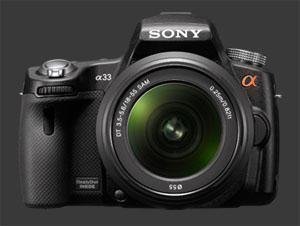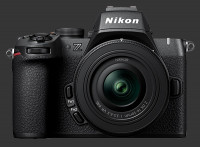ILCs Boldly Go Where No Cameras Have Gone Before
News
2010.08.30

No, I did not miss the announcement for the Sony SLT cameras. I was just floored by it and could not react until now ;) Yes, the SLT announcement is that big. There are important reasons why, which lie in what this type of cameras could be capable of. The first two models introduced, the SLT-A55 and SLT-A33, appear to be both very capable in unique ways but there could be even more to come.
As a quick recap, Sony introduced two new cameras called SLT-something where the SLT stands for Single Lens Translucent. It's not a coincidence that the first two letters are the same ones that make up SLR. The difference lies in the T which stands for Translucent Mirror versus the R which is a Reflex Mirror. With a translucent mirror, there is no flipping up and down and, more importantly, no blocking of the AF and metering sensor during an exposure. While in theory there could be an optical viewfinder in such a camera, it would be very dark and not have any of the advantages of EVFs. I'll go into more details about this further down.
Externally, these cameras look like small DSLRs. They have a lens mount which accepts standard Alpha lenses, the same as other Sony DSLRs and the Konica-Minolta ones before that. They have a sculpted body with deep hand-grip, viewfinder with rubber eye-cup and an integrated flash. Internally there are a lot of similarities too. The most important is that these cameras use the same 1.5X crop CMOS sensors as some of the latest DSLRs. This means that the A55 and A33 can capture 16 and 14 megapixels images, respectively, up to ISO 12800. They also both record full HD video at 1920x1080 @ 30 FPS in AVCHD format.
Although a lot is in common with modern DSLR cameras, SLT cameras have some very important capabilities. For photography, the headline-grabbing specification is 10 FPS continuous shooting with full-time continuous autofocus. 10 FPS is truly very fast and only a select and very expensive few DSLRs can do it. The main reason why it is difficult to shoot at 10 FPS for a DSLR is that the mirror has to flip up and down at 10 FPS. The shutter too but a reflex's mirror is much heavier than its shutter. It takes time to move the mirror up and down and while the mirror is down, a normal camera cannot autofocus. So, when DSLRs shoot at such speeds they actually don't continuously focus on the subject, they simply guess when the subject would be. This is called Predictive Autofocus. At 10 FPS, there has to be much less than 1/10s between each frame and that is not enough time to autofocus in most situations. An SLT camera on the other hand can focus between and during the exposure. It can therefore perform its calculations and tracking continuously.
The second more important advantage of the SLT model is for videography, which is likely the reason why Sony created these two cameras. Up to now, DSLRs have been coming out with video capabilities but usually suffered mostly from their inability to focus during video recording. Recent advances let some DSLRs use contrast-detect AF while recording video but that is much slower than phase-detect autofocus normally used in DSLR cameras.
 The final important key is the use of an EVF rather than an optical viewfinder. An EVF has the advantage of showing images and video as seen by the sensor. This means that exposure, white-balance, dynamic-range and such can all be taken into account. With a good system, an EVF can show exposure rather accurately and even a heads-up live-histogram. This greatly reduces the need to check exposure after the picture, aka chimping, and missed exposure. This is what Live-View has been about... Seeing 100% of the results before taking the picture. In practice, small discrepancies can exist but compared to an OVF, the preview is much more realistic. Incorrect white-balance should be a thing of the past too with an EVF.
The final important key is the use of an EVF rather than an optical viewfinder. An EVF has the advantage of showing images and video as seen by the sensor. This means that exposure, white-balance, dynamic-range and such can all be taken into account. With a good system, an EVF can show exposure rather accurately and even a heads-up live-histogram. This greatly reduces the need to check exposure after the picture, aka chimping, and missed exposure. This is what Live-View has been about... Seeing 100% of the results before taking the picture. In practice, small discrepancies can exist but compared to an OVF, the preview is much more realistic. Incorrect white-balance should be a thing of the past too with an EVF.
The traditional EVF has had two drawbacks. First off is the lack of precision. EVFs made it very easy to see exposure and color but made it very difficult to see focus. This is changing since the introduction of 1.44 megapixels EVF that are extremely precise. It will not be long before we can produce EVFs more precise than the human eye. The next is the display lag. There is some circuitry that reads the sensor and produces the image seen on the EVF. The time it takes to operate this creates a lag. Although such lag is measured in fractions of a second, it is noticeable when following action and fast-moving objects. Over time this will improve too. We just have not seen how much this is a problem with these new cameras.
In movie-recording mode, EVFs also shine. They give an eye-level view of the video being recorded as well as stability and framing precision which is much harder to obtain when holding a camera away from your body. With normal DSLRs, movie-mode is always done in Live-View, so the rear non-eye-level LCD has to be used. Sony intended to add video to DSLRs when they could offer something truly distinctive, and they did in the form of these SLT cameras. This is probably not the only solution, there are others, but the importance is that Sony is presenting a solution to enable continuous AF while filming. Another solution would exist by following Fuji's example, with their apparent mastery of complex sensor circuitry. In their recently announced compact F300 EXR camera, Fuji has created a sensor which can capture images and perform phase-detect AF at the same time. Of course, there could be even more ways. It really does not matter how it is achieved, what is important is to give the most complete movie recording mode possible, to capture the market of photographers who occasionally do video and do not want to carry a video camera as well as a still camera.
The 16 megapixels SLT-A55 will be available in October and can be already pre-ordered from BHPhoto. They also accept pre-orders for the 14 megapixels SLT-A33.
- Digital Camera
Please Support Neocamera
All information on Neocamera is provided free of charge yet running this website is a huge endeavor. Purchases made via affiliate links found throughout the site help keep it running and up-to-date. There is no additional cost to you, so please consider buying via these links to our affilates:
If you found any information on this site valuable and did not purchase via our affiliate links, please considering donating via PayPal:
Any amount will be greatly appreaciated. Thank you for your support!
New Cameras & Lenses

Nikon Z5 II
24 Megapixels Mirrorless
Nikon Z Lens Mount
Built-in Stabilization
Weatherproof
2025-04-03
Canon RF-S 14-30mm F/4-6.3 IS STM PZ
Stabilization
Canon RF Mount Zoom
2025-03-26
Canon RF 20mm F/1.4L VCM
Weatherproof
Canon RF Mount Prime Lens
2025-03-26
Canon EOS R50 V
24 Megapixels Mirrorless
Canon RF Lens Mount
2025-03-26
Venus Optics Laowa 14mm T/2.6 Zero-D VV Cine
Sony E Mount Prime Lens
2025-03-25
Venus Optics Laowa 14mm T/2.6 Zero-D VV Cine
Nikon Z Mount Prime Lens
2025-03-25
Updates
2025.01.18

Fujifilm GFX 2025 Lens Roundup
Lens Review roundup of Fujifilm GFX Medium-Format lenses. Quality, performance and handling of the GF20-35mm F/4R WR, GF30mm F/3.5 Tilt-Shift and the GF55mm F/1.7.
2024.11.18

Best 2024 Photography Gifts for Every Budget
Great gifts for photographers and photo enthusiasts selected for every budget among the best products of 2024.
2024.08.07

Eye Protection Tips for Professional Photographers
The four main considerations for professional photographers regarding eyewear.
2024.07.14

Fujifilm X100VI Review
Flagship fixed-lens compact digital camera with a 40 MP sensor and Image-Stabilization, a first for the series. Retro design featuring dual control-dials, plus direct ISO, Shutter-Speed and EC dials. Its hybrid viewfinder can switch between EVF and OVF mode.
2024.05.09

Fujifilm GFX100 II Review
Flagship 102 Megapixels Medium-Format Mirrorless Digital Camera with 8-Stop 5-Axis IBIS, 8 FPS Drive, 8K Video and 400 MP Super-Resolution capture in a weatherproof and freezeproof body with dual control-dials and dual memory-card slots.
2024.04.03

Fujifilm X-T5 Review
Newest Fujifilm flagship boasting a 40 MP APS-C sensor, 5-axis IBIS with 7-stop efficiency, 15 FPS continuous drive, 6.2K Video capture, dual control-dials and dual SDXC UHS-II slots in a sturdy weatherproof and freezeproof body.
2023.11.20

Best Digital Cameras of 2023
Find out which are the Best Digital Cameras of 2023. All the new Mirrorless Digital Cameras from entry-level to high-end professional.
2023.07.10

Fujifilm X-H2 Review
40 Megapixels APS-C Hybrid Mirrorless Digital Camera with 7-stop IBIS. Fastest shutter ever and 8K video capture. Large builtin EVF with 0.8X magnification and 5.8 MP, plus an Eye-Start Sensor. Packed with features and large number of controls in a weatherproof and freezeproof body.
2023.05.07

Sony FE 20-70mm F/4G Review
Review of the unique Sony FE 20-70mm F/4G lens. The optical zoom of this lens spans ultra-wide-angle and medium focal-length coverage, making it one of the most versatile Full-Frame lenses on the market.
2023.01.15

Huion Inspiroy Dial 2 Review
Review of the Huion Inspiroy Dial 2 tablet, a medium sized drawing surface with dual dials and customizable buttons. Connects via USB-C or Bluetooth 5.0 with Windows, Linux and Android support.
2022.12.08

How to Pack for a Photo Trip
Find out how to pack for a travel photography trip, carry your gear safely while meeting airline regulations.
2022.11.13

Best Digital Cameras of 2022
The best digital cameras of 2022. A short list of the most outstanding models in their respective categories. Choose one for yourself or as a gift.







